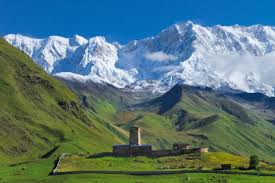

The Svan culture shows clear ties with ancient Sumeria and Mesopotamia, though many Svans are blonde with green eyes. They've lived here since the 2nd millennium BC, and the foundations of the oldest defensive towers can be dated to the 1st century BC. These towers are Svaneti's most distinctive feature, more elaborate than those in Khevsureti and elsewhere to the east, with fortified tops and roofs. There are now about 175 towers, dating from the 6th to 16th centuries (most being from the 9th to 13th centuries), and a couple of dozen have been restored.
In Roman times the Greek geographer Strabo called the Svans 'a mighty people ... foremost in courage and power'; they were formally Christian by AD523 but even today their religion retains strong elements of paganism, such as sacrificing rams on religious festivals and placing their horns on the altar. The Svan sun god Lile may well be the same as the Sumerian Enlil, and the village of Lakhamu may be named after the Sumerian water god. Now, St Barbara is seen as an equivalent of the sun god, while St George (Dzgrag) is revered as an equivalent to the moon god. Nominally under the control of Colchis, then Lazika (Egrisi), Svaneti became part of Abkhazia then of a unified Georgia from the early 11th century; it shared in Georgia's golden age under Queen Tamar (who ruled from 1184 to 1213), who visited Svaneti several times and is still revered there. The Svans were largely undisturbed by the Mongols (although Tamerlane's horde passed through in 1397), and came under a Russian 'protectorate' in 1833, local autonomy being abolished in 1857; the last Tsarist governor was driven out in 1905, leaving Svaneti effectively independent until 1924.
The wheel and the aeroplane both appeared in Svaneti in 1935; given their eight-month winter and the permanently ruinous state of the roads, many Svans are still happy to use heavy ox-sledges as a means of transporting goods. However increasing numbers now live for most or all of the year in Tbilisi or other cities, as the disadvantages of the harsh mountain lifestyle become ever clearer. In Rustavi, built after World War II as a new industrial city, there are now Svan villages. In the winter of 1987 a terrible avalanche killed around 70 people at once, mostly children in a school in Ushguli, and the following year around 4,000 of the 16,000 residents of Zemo (Upper) Svaneti left. In all there are 45,000 Svans in Georgia, of whom 12,000 remain in Zemo Svaneti, about 2,500 of them in Mestia. Logging (probably about double the official level of 60,000m3 per annum) is leading to more avalanches and landslides, and 75-80 families are still leaving each year.
A typical Svan village is actually composed of perhaps half a dozen separate clusters of around 30 households huddled around their defensive towers. These are normally about 28m tall (perhaps following a formula by which the height of the tower should equal the sum of the four sides), and unlike those of Ossetia and elsewhere they are crenellated and roofed. They were probably built by spiral scaffolding, with rocks hoisted up by oxen. In some villages the oldest and largest will be the 'war tower', standing separately on a hilltop. The traditional home or machubi consists of one spacious room with living space in the centre separated by carved wooden partitions from the livestock stalls around the walls. Churches are generally tiny, just 5-6m2, and they're single-nave basilicas, mostly built between the 8th and 14th centuries, with frescoes painted between the 10th and 12th centuries, both on the inside and the outside of the churches. They tend to be opened perhaps twice a year for festivals, but the key holder may let you in. Svan icons are remarkable for the standard of their chased metalwork, and the finest examples, made at the end of the 10th century and start of the 11th century, are kept safe in the homes of the leading families.
eurasia.travel.com